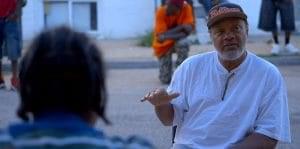
The current crime epidemic in Baltimore is so multifaceted that it’s hard to have a productive conversation about it. So when viewers, particularly from outside the city, consume media that claims to explain the issues, we have to do so with a cautious attitude. There are so many variables that capturing the “reality” of Baltimore’s violence on film is impossible. Of course, that doesn’t mean it’s not essential to try.
The documentary Charm City casts a wide net in profiling community organizers, city council members, and police officers trying to fix Baltimore’s systemic issues. Crucially, while this film is in part about activists, it’s not an “activist documentary.” Director Marilyn Ness started filming shortly after Freddie Gray’s murder at the hands of Baltimore police officers in 2015, but if viewers expect Charm City to be an anti-police exposé, they’ll be disappointed.
Everyone profiled in this film ends up looking like a good person trying to do right by their city. Even though there’s almost no exposition in Charm City (occasional statistics appear on the screen, you feel Ness’s editorial hands guiding the film to be as universally compassionate as possible. Her purpose is not to help the viewer “understand” Baltimore, but to bring together its various subjects and show their common goals—to build a community through editing.
“…profiling community organizers, city council members, and police officers trying to fix Baltimore’s systemic issues.”
The filmmakers wisely give the most screen time to the Rose Street Community Center and its Safe Streets program, which uses de-escalation tactics and community outreach to resolve potentially violent situations without any arrests. We watch as former corrections officer Clayton “Mr. C” Guyton, the director of the organization, and his protégé Alex Long hold meetings, counsel people in risky situations, and stop arguments before anyone gets hurt. Learning about these men’s personal histories and how they’ve channeled their experiences into community organizing is the best part of Charm City. It helps the viewer imagine a future that doesn’t require a massive armed police presence to make neighborhoods like Rose Street safer.
After Charm City’s opening credits, in the first of Mr. C’s talks that we see, he discusses the need for police intervention and “snitching” in some cases: “If my brother is walking down the street with me, and somebody kill him, and I tell on him, that’s love.” Later in the film, Long videotapes a police traffic stop and harangues the officers for collecting traffic tickets and doing nothing to stop the murders in his neighborhood. The contrast between these scenes illustrates the delicate tightrope the film has to walk between accurately representing the Rose Street community’s fraught relationship with the police and treating that same police with sympathy.
In the policing sections of Charm City, we spend time with captain Monique Brown and officers Eric Winston and John Gregorio. Their interviews emphasize their reasons for joining the force, their considerate treatment of citizens, and the understaffing that requires them to work brutal hours. Other than a brief, downplayed argument with the state’s attorney’s office over a fourth amendment violation, there’s nothing here that you wouldn’t expect to see in ridealongs with a camera crew present. These are scenes of good cops doing their jobs, with no reflection on the department’s reputation following Freddie Gray’s death—the filmmakers consciously avoid the hot-button issue of unjustified police violence.
“…no sense throughout the film that his ideas attract broad support…”
Another primary subject of Charm City is Brandon Scott, a city councilman who is trying to reform Baltimore policing. We see him argue against mandatory minimum sentences and push for policy changes that would increase institutional support for at-risk families. His ideas sound great, and there are some nice scenes of Baltimore politicians grandstanding against excessive police spending. However, there’s no sense throughout the film that his ideas attract broad support. I wasn’t sure what to take away regarding Baltimore’s political climate and the city bureaucracy.
In the years that Ness’s cameras were rolling, Rose Street lost a lot of people, and the film makes you feel the weight of those losses and the never-ending grieving process. When Charm City focuses on Mr. C and the Safe Streets program, it’s a heavy look at the toll of violence on a Baltimore community. When it focuses on other subjects, it’s less sure of itself. There are so many perspectives to sort through, and the fly-on-the-wall style leaves all the work of that sorting to the viewer. The movie would have the viewer believe that more honest communication between police and citizens would help with the healing process, but in giving both of those parties a voice, it just shows how large the gap between them really is.

Charm City (2018). Directed by Marilyn Ness. Featuring Clayton Guyton, Alex Long, Brandon Scott, Monique Brown, Eric Winston, John Gregorio.
7 out of 10 stars

